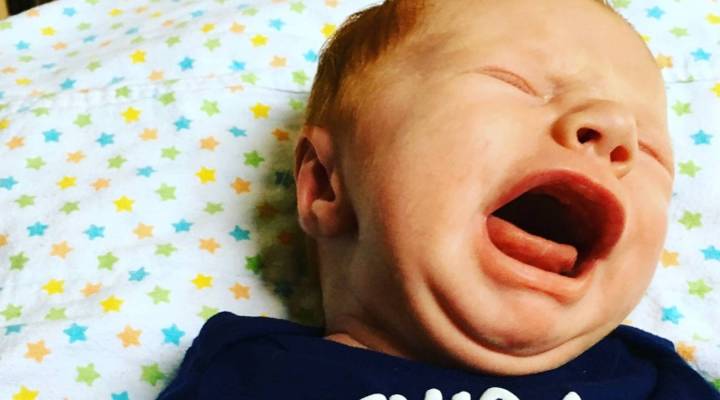
Sleeping like a baby is a $325 million industry

Lindsay Barrick and her husband had been trying to get their baby Arlo down for his nap for almost an hour.
“He sounds so miserable,” said Barrick, bouncing her screaming infant up and down. “I know, if you just would go to sleep you’d feel better!”
It would definitely make Arlo’s parents feel better. Since this adorable red-haired baby was born three months ago, they haven’t gotten much sleep. The previous night, Barrick and her husband Jerry Talkington, who live in Oakland, Calif., were up three separate times with Arlo.
“I sort of feel like I would do anything — sell my soul, I don’t know — for a few hours of sleep,” Barrick said, laughing.
Any parent who has lived with a newborn knows sleep is a valuable commodity. So it’s no wonder that parents will try just about anything to get their babies to sleep through the night. Nationwide, the wholesale infant sleep industry is worth more than $325 million a year, according to figures reported by companies to the Juvenile Products Manufacturers Association.

Lindsay Barrick and Jerry Talkington are doing their best to follow all of the safe sleep recommendations for their baby Arlo, while also enjoying being parents.
So far, Barrick and Talkington have spent about $250 on products to help Arlo sleep, including an $80 vibrating bassinet and swaddling blankets.
The companies that make infant products know parents like this couple aren’t just losing sleep because their babies are crying. It’s also because they’re worried about protecting their newborns from suffocation, strangulation or Sudden Infant Death Syndrome, which kills 3,500 each year in the United States as they sleep.
To prevent SIDS, babies are supposed to sleep on their backs. Recently, a new “smart bassinet” entered the market that’s designed to keep babies from rolling over. The Snoo Smart Sleeper costs $1160 and is advertised as “the safest baby bed ever made.” The marketing materials don’t mention SIDS specifically, but inventor Dr. Harvey Karp said safety is one of the Snoo’s biggest selling points:
“A lot of people find the value proposition just in knowing that their baby can’t roll to a dangerous position. You put your baby in, you have peace of mind, you don’t have to check your baby. That’s like insurance. That’s worth the price of admission,” said Karp.
Karp is the author of “The Happiest Baby on the Block” and is well-known for a technique he calls “the five S’s” that helps parents sooth their babies to sleep through a combination of swaddling, shushing and bouncing. The Snoo does that automatically by responding to a baby’s cries.
“This bed will move all night long, gently rocking the baby back and forth, making white noise that’s like the sound of rain on the roof,” Karp explained at a recent show of the latest baby products, at an American Academy of Pediatrics conference in San Francisco. “If the baby gets upset, the bed makes more jiggly motions and a louder sound, which is exactly what an experienced parent does when a baby is crying.”
The FDA says the makers of a broad range of products claim that they reduce the risk of SIDS, including baby monitors, infant positioners and mattresses.
The American Academy of Pediatrics does not evaluate individual products, but the group discourages buying any product that claims to reduce the risk of SIDS. “There’s no evidence that any of these products actually do that,” said Dr. Lori Feldman-Winter, co-author of the Academy’s latest recommendations on safe sleep.
The things that actually keep a baby safe are cheap or even free, explained Feldman-Winter. Put the baby’s bed in the parent’s room for the first year. Place the baby on its back. Breastfeed.
And when it comes to a bed, she said, less is more: “A cardboard box that has a firm mattress that has a tightly fitted sheet with no other objects may be perfect for a baby.”
Many of the sleep products on the market are actually dangerous for babies, added Feldman-Winter. “There’s a lot of marketing about the aesthetics of what a sleep environment looks like. If you go into any baby stores just look at what’s for sale for infants, it all looks cozy and pretty and fluffy.”
But cozy and fluffy can be hazardous. Things like pillows and blankets increase the risk of suffocation. A safe baby bed is empty of everything except the baby, said Feldman-Winter.

“When he wakes up from his nap and he has just the cutest smile on his face,” said Arlo’s mom Lindsay Barrick.
Barrick and Talkington are doing their best to follow all of the recommendations while also enjoying being Arlo’s parents, despite the sleeplessness.
“When he wakes up from his nap and he has just the cutest smile on his face, we’re like ‘OK, I guess it’s worth all the exhaustion and the frustration,’” said Barrick.
The good news is that they may get some relief soon. Most babies are sleeping through the night by about six months.
This story is produced through a collaboration between Marketplace and Kaiser Health News.
There’s a lot happening in the world. Through it all, Marketplace is here for you.
You rely on Marketplace to break down the world’s events and tell you how it affects you in a fact-based, approachable way. We rely on your financial support to keep making that possible.
Your donation today powers the independent journalism that you rely on. For just $5/month, you can help sustain Marketplace so we can keep reporting on the things that matter to you.












